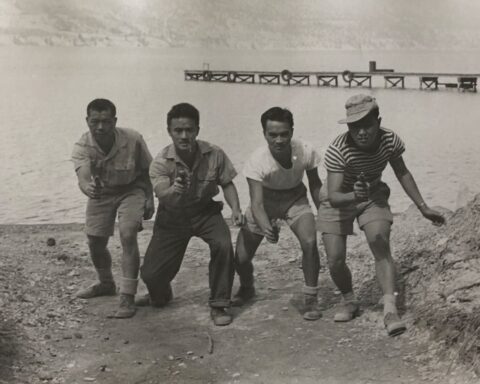In November 2006, the Toronto Reel Asian International Film Festival (TRAIFF) rolled out its red carpet for the North American premiere of After This Our Exile, a feature shot in Malaysia by Hong Kong’s Patrick Tam. The huge and enthusiastic crowd attending the event was not wrong. The film has since garnered three Golden Horse Awards (Taiwanese Oscars) including best picture, best lead and best supporting actors. 2006 proved to be a record-breaking year for TRAIFF with a twenty percent increase in attendance. With festivals like TRAIFF and the Vancouver Asian Film Festival (VAFF), international stars as recognized as Sook Yin Lee and Sandra Oh and filmmakers like Ann Marie Fleming and Julia Kwan, it seems that, finally, Asian Canadians and their films are being celebrated across the country.
Although Asian film festivals like TRAIFF, VAFF and the Calgary Pan Asian festival are a comparatively new phenomena, Asian Canadians first ventured into filmmaking in the late ’60s and early ’70s. Some were visual experimentalists while others were socio-political activists who worked in documentaries. The best known of these pioneers were future Governor General Adrienne Clarkson and Jesse Nishihata, both of whom worked in TV documentaries.
There was not much of an indie scene forty years ago, but more independent productions started to appear sporadically in the mid-’70s. The first Asian Canadian experimental feature Everything Everywhere Alive Again (1975) was made by Keith Lock (Lock Kei Kong), who started making films in 1969 when he was seventeen. His student film Flights of Frenzy, won the Best Super-8 Award at the UNESCO Tenth Muse International in Amsterdam. Apart from being one of the first Asian Canadian filmmakers, Lock also contributed to the entire community by being a founding member of the Toronto Filmmaker’s Co-op in 1969, which eventually was transformed into LIFT (Liaison of Independent Filmmakers of Toronto).
The ’70s produced lots of experimental artists with the arrival of avant-garde film and video scenes in Toronto, Montreal and Vancouver. This movement inspired some Asian artists to try their experiments on film or video. In 1977, after working at the CBC for years, Jesse Nishihata independently produced The Inquiry Film: A Report on the Mackenzie Pipeline Inquiry, which went on to win a 1977 Canadian Film Award (the future Genies) for best documentary over 60 minutes. In mainstream cinemas, though, Asians were invisible on the Canadian screen with the exception of Bruce Lee flicks or other martial arts films.
The ’80s were the planting and germinating period for Asian Canadian filmmaking. All four major areas of filmmaking—experimental, animation, documentary and drama—saw the emergence of Asian Canadian talent, thanks in part to years of nurturing by the CBC and NFB. Experimental works, particularly in video, were embraced by Canada’s burgeoning arts scene. The extended run of Wayne Wang’s Chan Is Missing (1982) helped raise Asian consciousness, and showed Asian Canadians that the market was ready for diversity on screen. Finally, Asian Canadian dramas—mainly shorts—started to emerge. These films were usually made by struggling first generation Asian immigrants, or root-searching second and third generation Asians.
The Asian Canadian population at that time was a diverse mix. The first wave of Asians arrived in Canada in the late 1800s, and by the 1980s, their offspring were third or even fourth generation Asian Canadian. With government immigration policies welcoming Asians in the 80s, there were also fresh-off-the-boat immigrants who were still struggling to fit in. Their experiences were poles apart and they had very different concerns and priorities, as reflected in the diversity of their stories.
Diversity exists even within the same generation. Art has never been a popular career choice among Asian Canadians. Most immigrant parents perceive the arts as being an unstable source of income, which they discourage their children to go into, when they themselves have little to fall back on. It took a lot of guts and determination for Asian Canadian filmmakers to assert themselves in the late ’80s. Some of them had an inclination towards filmmaking very early on in life, like Mina Shum and Ann Marie Fleming, but others stumbled into the director’s chair by accident. Julia Kwan wanted to be a writer but ended up a director as she doesn’t feel comfortable letting others fiddle with her words. Richard Fung is a social activist turned director. Khanhthuan Tran went to art school to study painting and came out a filmmaker. Their different paths have created diversity within this first mature generation of film and video makers. Yet, their stories are always personal, uniquely Canadian with an Asian flavour and never made as genre pieces.
Many Asian Canadians have experimented with different film genres. Ann Marie Fleming has produced an impressive body of work and garnered awards in areas as diverse as personal documentaries, experimental films, animation and dramas. Keith Lock has gradually moved away from experimental work into dramas and documentaries. Midi Onodera, initially an experimental filmmaker, had at one point developed an interest in drama. Richard Fung started out as a documentary media activist and ventured successfully into personal and experimental videos. Their works have never been commercial, with most pieces being funded by themselves or through grants or family members. With film and video co-ops shaping up across the nation, they were able to work independently on a small budget, but it also limited the length, and audiences, of their productions.
It was only in 1990 that Ann Marie Fleming was able to make a dramatic feature, New Shoes. Other directors eventually followed. Keith Lock made his first dramatic feature Small Pleasures in 1993. In 1994, Mina Shum wrote and directed Double Happiness and Midi Onodera directed Skin Deep. By choice, most of these works were somewhat marginalized because of very strong Asian content and a very specific audience in mind. Theatrical releases of these Asian Canadian films were limited to specific communities and repertory theatres and never received strong nation-wide distribution. However, the films explored major themes and some sophisticated mainstream movie-lovers started to notice them at film festivals. The favourable critical response to most of this clutch of dramatic features increased the visibility of Asian Canadian films, inspiring the next generation of filmmakers. They started to emerge with their own works: directors like Helen Lee, Larissa Fan, Julia Kwan, Nicole Chung, Romeo Candido, Min Sook Lee, Cheuk Kwan and Sook Yin Lee. Dylan Akio Smith, director of the award-winning short Man Feel Pain (2004), has openly cited being influenced by Ann Marie Fleming.
Despite their increasing numbers, Asian Canadian independent productions did not garner more screen time as major film festivals continued to be dominated by a mainstream cinema with limited Asian representation on screen. Noticing this growing gap between Asian filmmakers and their audience, Toronto (TRAIFF) and Vancouver (VAFF) niche festivals emerged concurrently in 1997. Their mandate was to showcase films with an Asian connection, particularly by North American Asian filmmakers.
First-time or emerging Asian filmmakers shut out of major film festivals finally got exhibited. Veteran filmmakers also got a chance to showcase their more personal works in-between major projects. Asian Canadian filmmakers who had a remarkable body of work could be introduced as spotlight artists, like Mary Stephen, (who has worked with Eric Rohmer extensively as an editor), the subject of TRAIFF in 2002. Showcasing films from Asian countries provides a chance for cultural and artistic exchanges, thus inspiring creativity.
It may seem that filmmaking is easier for Asian Canadians now, since the arrival of digital video technology which can lower the cost of filmmaking significantly, but the budgets for independent films have gone down, too. Like struggling Asian Canadian filmmakers, their film festivals are also challenged, especially in recent years. With the increasing popularity worldwide of DVDs and video downloading on the Internet, audiences nowadays are not as reliant on film festivals to access Asian films. The festivals have to constantly reinvent themselves to stimulate audience growth. TRAIFF has just started a free database service at www.rafilms.ca to serve the Asian Canadian film community year-round.
Another way of ensuring an audience is by premiering the works of established Asian filmmakers, but this has become a challenge as well. The Asian festivals have become victims of their own success— they no longer have the chance to premiere or even program established filmmakers’ works after they have graduated to major film festivals. Programming the best in the Asian Canadian film community, which is very much their intention, has become impossible. Films like Long Life, Happiness and Prosperity by Mina Shum and Eve and the Firehorse by Julia Kwan were not programmed at the TRAIFF as they were premiered at the Toronto International Film Festival (TIFF) two months previously, and would not have drawn much audience interest again.
Shortage of funding is another challenge. Government grants are getting less reliable as the budget for the arts keeps going down while the number of applicants rises. A film festival needs to grow to justify funding as well as attract corporate sponsorship. The way to increase audience attendance and industry participation is by flying in high- profile stars and important Asian film producers, but it’s extremely expensive. This essential growth component cannot materialize without the support of astute sponsors who share the festivals’ vision.
Although the environment of Asian Canadian filmmaking is much improved and more opportunities are available, the process of funding and making works here is still highly challenging. Asian film festivals continue to work hard to nurture and grow the community. VAFF has introduced the “Mighty Asian Moviemaking Marathon” (MAMM), a one week filmmaking competition for young filmmakers and TRAIFF has launched the first ever Reel Asian Industry Series providing networking access for Asian Canadian professionals, from emerging filmmakers to established funders and broadcasters. The festivals have also been instrumental in breaking down Asian stereotypes. Canada celebrates diversity, but the percentage of Asian content film at TIFF only rounds up to about ten percent, far less than films from Europe or the United States. Asian Canadian filmmakers and festivals will have to work together strategically to create more exposure and recognition in the years to come. It may be time to celebrate a lot of hard-won success, but the work for Asian Canadian filmmakers and impresarios continues.











